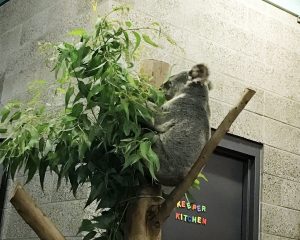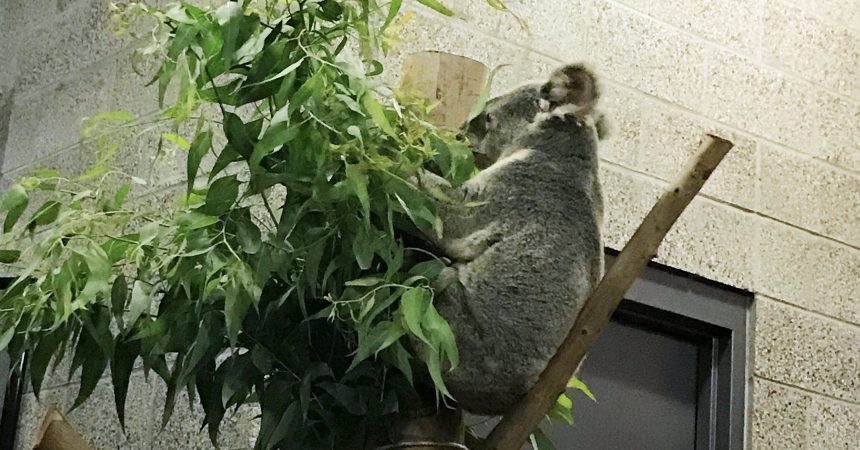Zoo InternQuest is a seven-week career exploration program for San Diego County high school juniors and seniors. Students have the unique opportunity to meet professionals working for the San Diego Zoo, Safari Park, and Institute for Conservation Research, learn about their jobs, and then blog about their experience online. Follow their adventures here on the Zoo’s website!
 We can all be picky eaters sometimes, and koalas are no different. Their diet consists of only eucalyptus, which is a type of tall, flowering tree. They will only eat about three dozen different species of eucalyptus out of the six hundred that exist, and each koala has his or her own preferences and favorites. This past Thursday, my fellow interns and I had the opportunity to learn more about these picky eaters and meet with Katie Tomlinson, a Senior Zoo Keeper who works primarily with giraffes, Tasmanian devils, and koalas.
We can all be picky eaters sometimes, and koalas are no different. Their diet consists of only eucalyptus, which is a type of tall, flowering tree. They will only eat about three dozen different species of eucalyptus out of the six hundred that exist, and each koala has his or her own preferences and favorites. This past Thursday, my fellow interns and I had the opportunity to learn more about these picky eaters and meet with Katie Tomlinson, a Senior Zoo Keeper who works primarily with giraffes, Tasmanian devils, and koalas.
Ms. Tomlinson explained that koalas’ picky diet can make it difficult for zoos to take care of koalas, but luckily the climate in San Diego is similar to that of their native environment in Australia, making the Zoo a perfect spot to grow eucalyptus. A full-time horticulturist is employed to tend to an on and offsite eucalyptus browse farm, where bundles of tree branches are harvested each day for the picky eaters. With twenty-four koalas currently onsite and additional koalas on loan to other zoos, the San Diego Zoo is home to the largest group of Queensland koalas outside of Australia.
Ms. Tomlinson also introduced us to Burley, a koala and animal ambassador. Burley’s name means “star” and, like most of the other koala names at the Zoo, has roots in traditional Australian Aboriginal language. Burley is aptly named: he has been a media star with local and national news appearances, bringing attention to the conservation issues that koalas face in the wild.
Eucalyptus acts as both a food source and home for wild koalas. It has low nutritional value, so the koalas must conserve their energy and spend most of their day sleeping (which they do in the trees). Their safety is jeopardized by drought and human-related threats, such as habitat loss caused by urban development and encounters with cars and domestic dogs. When trees are cleared to make way for human built structures, the koalas’ food source and shelter are eliminated as well. Roads can run though and divide their habitat, separating them from other koalas and potential mates. Without food and the ability to reproduce, their future is in question.
Zoo Keepers like Ms. Tomlinson work in research and animal husbandry. Koalas are marsupials, meaning they carry their babies in their pouches. Their gestation period is only 34-36 days, so the baby comes out underdeveloped and only the size of a thumbnail. Once the baby is born, it crawls into the mother’s pouch and latches onto her for milk. Ms. Tomlinson carefully monitors the pregnancy and the growth of the baby. The San Diego Zoo also works with keepers at other zoos to introduce potential breeding pairs. Koala lineages are recorded to ensure that breeding promotes the best genetic diversity. Once a pair is selected, a koala will go “on loan” and travel to another zoo for breeding. The San Diego Zoo currently has over fifty koalas on long and short-term loan. Reproductive success is important because it helps stabilize the koala population both in managed care and in the wild, which is vulnerable to endangerment.
Although koalas live thousands of miles away, there are many ways to help them and other animals right here from home. A great first step is visiting your local zoo to learn about koalas and other species and then sharing that information with your friends and family. Through education, you can help protect local species that are similarly threatened by drought, development, and other animals that can harm them. Keeping dogs on leashes protects Southern California wildlife, and reducing water usage by taking shorter showers and watering lawns with recycled water helps conserve our valuable resources. It is easy for everyone to take part in saving our environment. Together, we can work to ensure the livelihood and existence of all animals, from the Australian koala to the the ones native to our own Southern California ecosystems.
Kendall, Conservation Team
Week Five, Fall Session 2017


